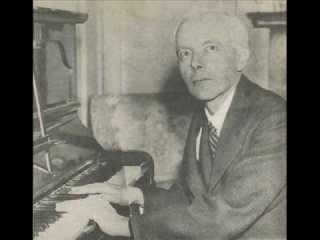Béla Bartók - Sonatas for Violin & Piano No.1, Sz. 75 & No.2, Sz. 76
Béla Bartók - Sonatas for Violin & Piano No.1, Sz. 75 & No.2, Sz. 76

Sonata for Violin & Piano No.1, Sz. 75 1. I. Allegro appassionato 2. II. Adagio 3. III. Allegro David Oistrakh - violin Sviatoslav Richter – piano Grand Hall of Moscow Conservatory, 29.03.72 Sonata for Violin & Piano No.2, Sz. 76 4. I. Molto moderato 5. II. Allegretto Bruce Berg - violin Tibor Szász – piano January 14, 1990 USA
Béla Bartók wrote both of his violin sonatas for the Hungarian violinist Jelly d'Aranyi. Of the two works, the Sonata No. 1, Op. 21, is more traditional, both in structure and temperament; its three clearly delineated movements are marked by a character that is alternately rhapsodic and violent, but always virtuosic. Despite any appearance of conventionality, however, the sonata represents one of Bartók's most radical statements in its expressionistic rhetoric and its near-atonal harmonic and melodic language (notwithstanding the nominal indication that it is in the key of C sharp minor). The arresting opening bars are underpinned by fast, dissonant arpeggios from the piano that evoke the sounds of the cimbalom, a dulcimer-like instrument from Bartók's native Hungary. The violinist's first statement is broad and chromatic, a passionate declamation in a setting of nocturnal fantasy. Both harmonically and melodically, these opposing elements recall Bartók's contemporaneous stage pantomime The Miraculous Mandarin, completed in piano score two years previously. The movement is discursive and often impulsive; while there is confluence and cooperation between the two instruments throughout, thematic material is rarely shared. In this highly dissonant context, the occasional consonance sounds peculiar. A subsidiary theme, for instance, features the interval of a major sixth; often perceived as almost cloyingly sweet, it here emerges in an entirely different light. A searching cadenza-like solo passage for the violin opens the second movement. The piano eventually joins in with a series of ascending chords, no less unsettled for their limpid, impressionistic sonority; even in the turbulent setting of this work, Bartók's debt to the music of Debussy and Ravel is evident. A middle section is ominous and imposing, with frightening, arpeggiated octaves in the piano, increasing in volume as if some catastrophe were imminent; the violin, meanwhile, cries out in double stops and chords. The octaves recede, giving way to the desolate air of the opening. The finale is a series of increasingly wild dances, folk-like in style but wholly expressionistic. Bartók here makes his greatest demands upon the players' virtuosity and stamina as he leads them through a series of episodes that, however abstract in nature, arrange themselves roughly into a rondo form. Midway through is a grotesque pesante section marked by a thick and heavy stamping tread in the piano and detached skirlings from the violin in diffident response. The frenetic dance rhythms return, bringing the work to a grim conclusion. The Sonata No. 1 was premiered in Vienna by violinist Mary Dickenson-Auner and pianist Eduard Steuermann; d'Aranyi and Bartók first performed it at a private recital in London's Hungarian Legation in March 1922. ---Mark Satola, Rovi
Despite their conventionally accepted numbering, Béla Bartók's First and Second violin sonatas were actually the composer's fourth and fifth works in that genre. Bartók's three earlier sonatas, composed during his student years, are in a Romantic, almost Brahmsian, vein, and show few signs of the bold strides the composer was to make more than two decades later. During the years preceding the First and Second sonatas, Bartók, an accomplished pianist, often performed with violinists. He dedicated these two sonatas to one such musician, Jelly d'Arányi, a Hungarian-born violinist living in London. Performances of these works with d'Arányi and others quickly spread Bartók's reputation throughout Europe and garnered praise from Stravinsky, Ravel, Szymanowski, Poulenc, and Milhaud. In this work, which was composed between July and November 1922, Bartók abandoned the traditional three-movement form of the Sonata No. 1 , creating, instead, a more unified, two-movement composition. Nevertheless, the two works share some common features: their assimilation of Schoenberg's extreme chromaticism, and their finales, where the influence of dance music from Eastern European folk traditions comes to the fore. Of course, these movements are not actual folk music, but instead, a highly stylized treatment of folk-like material that prompted Bartók to warn a fellow Hungarian pianist: "We must be careful to avoid any attempt to put on such works as my two Sonatas for violin...in places where the level of music appreciation is as low as it is in Hungarian country towns. Such works would merely rouse antagonism in an audience which has not been trained to listen." The structure of this Sonata, for which the composer himself expressed a preference, can be considered a metaphor for the development of folk song as a natural outgrowth of improvisation. The work opens with a long melody in the style of a hora lunga -- a free improvisation found in Romanian peasant music -- that uses a small group of motivic patterns. This theme returns twice: once in an agitated guise at the end of the first movement, and then once again at the end, the climax of the sonata. In this final appearance, played in the violin's high register, the theme takes on a more stabilized shape in the context of the movement's dance rhythm. Bartók scholar Lászlo Somfai concludes that this plan reveals a hidden program to the sonata: "Bartók recreated the evolution of peasant music...in miniature, from the improvisatory 'ur-form' (using his own themes) to the crystallized stanzaic formation of lyric songs." ---Robert Adelson, Rovi
download: uploaded anonfiles mega 4shared mixturecloud yandex mediafire ziddu
Last Updated (Tuesday, 20 August 2013 16:04)








